复习课件7Bunit3
- 格式:ppt
- 大小:774.00 KB
- 文档页数:36
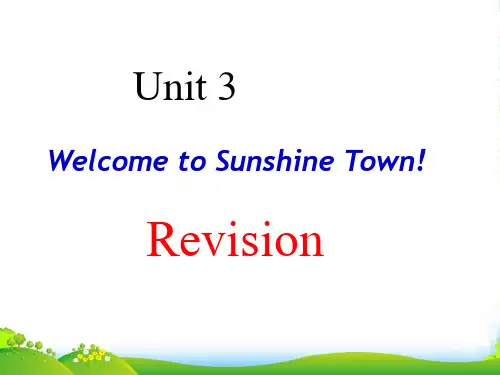
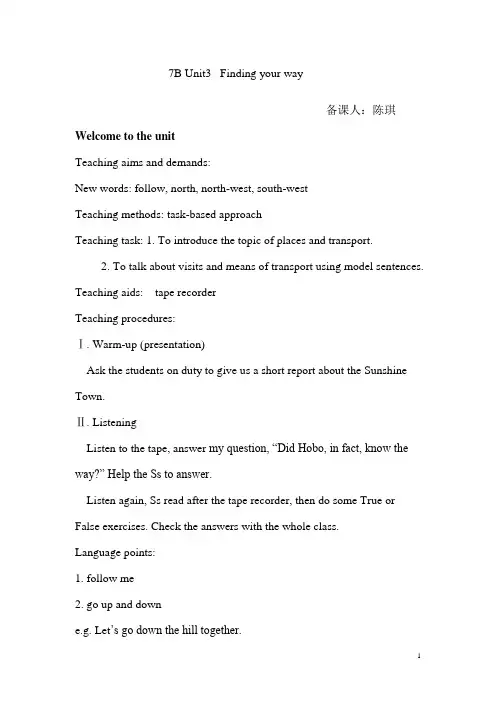
7B Unit3 Finding your way备课人:陈琪Welcome to the unitTeaching aims and demands:New words: follow, north, north-west, south-westTeaching methods: task-based approachTeaching task: 1. To introduce the topic of places and transport.2. To talk about visits and means of transport using model sentences. Teaching aids: tape recorderTeaching procedures:Ⅰ. Warm-up (presentation)Ask the students on duty to give us a short report about the Sunshine Town.Ⅱ. ListeningListen to the tape, answer my question, “Did Hobo, in fact, know the way?” Help the Ss to answer.Listen again, Ss read after the tape recorder, then do some True or False exercises. Check the answers with the whole class.Language points:1. follow me2. go up and downe.g. Let‟s go down the hill together.3. Don‟t be afraid.e.g. (1) Don‟t be late for school.(2) Don‟t play in the street. It‟s too dangerous.be afraid to do. be afraid of sth.. I‟m afraid that+从句e.g. (1) The little girl is afraid to go out in the evening.(2) Little Tom is afraid of dogs.(3) I‟m afraid that I can‟t go with you. I have a lot of work to do.Ⅲ. Main taskIntroduce the topic of place and transport.Ⅳ. Discussion (task)Talk about visits and means of transport using the model sentence …---Let‟s go to the zoo.---OK. We can go by bus.Language points:1. The zoo is north of Beijing Sunshine Secondary School.north ofsouth, west, north-west, south-weste.g. The library is south of the classroom.The playground is west of the classroom.2. ---How do we get there?---We can go by bus.by air/bus/car/bike/undergroundⅤ.Sum-upGo through the new words and the language points during this lesson. Ⅵ. Homework.Review the contents of this lesson.教后记:ReadingTeaching aims and demands:New words: call, robber, drive, quickly, at once, police, uniform, just, push, van, away, fail, use, knife, work, police station, route, along, right, another, stop, traffic, light, jump, later, suddenly, surprised, catch, in the end, crossroadsTeaching methods: task-based approachTeaching task: 1. Prepositions of movement..2. Simple fu ture tense with “shall” “will”Teaching aids: tape recorder, tapes, slide projector, slidesTeaching procedures:Ⅰ. Warm-upAsk the Ss to give a free talk. .Ⅱ.ListeningNow, listen to the text, please answer the question “Did the robbers run away finally?”Listen again, Ss read after the tape, and do some exercises.Ⅲ. ReadingSs read the articles by yourselves. Do the Exx on Page41and 42. Check the answers with the whole class.Language points:1.nearby=not far awaye.g. I live nearby in the building.2. robber(n.) rob(v.)e.g. The two robbers ran away from the back quickly.3. quickly=fast (adj.) quick (adj.)e.g. She walked quickly away.4. fail失败e.g. Tom failed in his math examination.5. work起作用e.g. Something is wrong with my watch. It doesn‟t work..6. route路线take different routee.g. There‟s another route you can take to get to the cinema.7. suddenly突然地.e.g. Suddenly I found a big tiger standing in front of me.8.surprised adj. 惊讶地e.g. We are surprised to hear him sing.9.in the end =at laste.g. He passed the exam in the end.10.turn right/left into 7th Streete.g. Don‟t tell a lie any more . It‟s not good for you.Ⅴ.Discussion (task)Have a discussion about the story.Ⅵ.Sum-upGo through the new words and the language points learnt during this lesson.Ⅶ. HomeworkReview the contents of this lesson.教后记:Vocabulary ﹠GrammarTeaching aims and demands:New words: straight, zebra crossing, entrance, correct, corner, road, hotel, cross, across, round, off, onto, train, tunnel, stair, railway, south, step, side, bridge, join, win, cloudy, paper, campfireTeaching difficulties: 1.prepositions of movement2. simple future tense with “will” and “shall”Teaching methods: task-based approachTeaching task: 1.To learn and know about the directions2.To prepositions of movement to give directions3.To recognize the use of “will” and “shall” and be going to talk about the futureTeaching aids: tape recorderTeaching procedures:Ⅰ. Warm-upHelp the Ss retell the story “A lucky escape”.Ⅱ. Vocabulary1.Ask the students what road signs they know, and list the names of the signs: e.g. turn left, traffic light, turn right, straight on ,crossroads.2. Ask the students to write the names under the pictures.3. Ask them how to read a map and circle the letters of the correct maps. Language points:turn right/left, cross the road, go straight along the road.Ⅲ.Grammar1.Prepostitions of movementWe use prepositions of movement to express movements. Prepositions of movement: across, along, down, from, into, off, onto, out of, over, round, through, to, upe.g. The bus goes to the airport.Simon is swimming across the pool.A train is going through a tunnel.Millie is walking along the road.Kitty is climbing up the hill.Hobo is walking round the table.Work out the rule: We use prepositions of movement after the verbs. Finish off the exercise on Page45.2. Simple future tense with “will” and “shall”We use “will” or “shall” when we talk about: things that will happen, plans that we are making now.e.g. She will be late for the party.We will take the dog to the park tomorrow.We make negative sentences like this:I/We will not/shall not goHe/She/It/You/They will not goWe ask questions using the simple future tense like:Will/shall I/We like go?Will He/She/It/You/They like go?We answer questions like this:Yes, I/we will/shall. Yes, he/she/it/you/they will.No, I/we will not/shall not. No, he/she/it/you/they will not.We can use “be going to” when we talk about:Fixed plans for a certain time in near future.e.g. I‟m going to take another route.Things that will probably happen.e.g. It‟s so cloudy. I think it is going to rain.We ask and answer questions with “be going to” like this.Am IAre you/we/they going to see the doctor tomorrow?Is he/she/itI am. I am not.Yes, you/we/they are. No, you/we/they are not.he/she/it is. he/she/it is not.Ⅳ. Discussion (task)Have a discussion and find out the differences between the simple future tense and simple present tense.Ⅴ.Homework1. Review the contents of this lesson.2. Do the Exx of the workbook.教后记:Integrated skills and Study skillsTeaching aims and demands:Key points: Cross the bridge and turn rightTake the second turning on the right.Cross the road at the traffic light.Walk past the police station.Teaching methods: task-based approachTeaching task: 1.To recognize key expressions about directions.2.To use key information given instruction and undentify the specific order of them from listening.3. To produce formulatic responses to specific instruction.Teaching aids: tape recorder, tapes, slide projector, slidesTeaching procedures:Ⅰ. Warm-upAsk the student on duty to give a short talk.Integrated skillsⅡ.Finding treasure1.Ask the Ss to study the pictures in Part 1 carefully. Put a tick in the correct boxes. Check the answers and explain.2.Listen to the tape and tell the Ss to do the Exx on Page48and 49. Listen again if necessary. Check the answers with the whole class.Ⅲ. Speak up1.Listen to the tape recording and read after it.2.Ask the Ss to work in pairs to make up a new conversation for giving direction using the conversation in Part B as a model. Ask a few pairs to present their conversations to the whole class.Ⅶ. Study skills ( Making a grammar pattern book)Take the Ss through the text of this page. Have a discussion about the Internet. What does WWW stands for? Do you know any common browser name, some search engines. Talk about other key aspects aboutthe Internet.Language points:1.Cross the bridge and turn right2.Take the second turning on the right.3.Walk along a path.Ⅷ. Sum-upGo through the new words and the language points learnt during this lesson.Ⅸ. Homework1. Review the contents of this lesson.2. Do the Exx of the workbook.教后记:Main task &CheckoutTeaching aims and demands:New words: farewell, barbecue, picnic, invite, exit, everybody, complete, note, page, yours faithfully, monitor, signature, postcard, footbridge Teaching methods: task-based approachTeaching task: 1. To express direction and information in the contest of writing a letter of invitation.2.To check the use of prepositions of movement, the use of “will” and “be going to” to talk about the future giving of direction.Teaching aids: tape recorder, tapes, slide projector, slidesTeaching procedures:Ⅰ. Warm-upAsk the student on duty to give a free talk.Ⅱ. Main taskAsk the Ss to read the questionnaire, then complete it with students‟ own information.Ask the Ss to read the letter on their own and complete it with information from the questionnaire results on Page51.Ask the Ss some questions to check them.Ⅲ. Writing (task)Ask the students to write an invitation letter for your class‟s farewell party at your school. Draw a map and send it with your letter with the help of B2.Ⅳ. Checkout: Sending postcardsAsk the Ss to fill in the blanks with the correct forms of verbs and prepositions. Check the prepositions of movement and simple future tense. Ⅴ. WordsAsk the Ss to look at the picture and write the correct words to describe each picture.Language points:1. be + adj. + to doe.g. He is sad to fail in the exam.2.invite sb. to do sth.e.g. invite us to her homeLily invited us to have dinner at her home yesterday.3. yours faithfully4. send the postcard to my parents.Ⅷ. Sum-upGo through the new words and the language points learnt during this lesson.Ⅸ. Homework1. Review the contents of this lesson.2. Do the Exx of the workbook.教后记:。
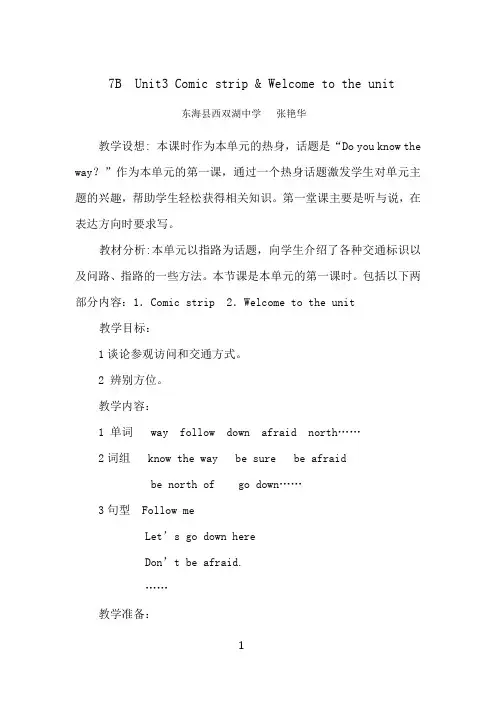
7B Unit3 Comic strip & Welcome to the unit东海县西双湖中学张艳华教学设想: 本课时作为本单元的热身,话题是“Do you know the way?”作为本单元的第一课,通过一个热身话题激发学生对单元主题的兴趣,帮助学生轻松获得相关知识。
第一堂课主要是听与说,在表达方向时要求写。
教材分析:本单元以指路为话题,向学生介绍了各种交通标识以及问路、指路的一些方法。
本节课是本单元的第一课时。
包括以下两部分内容:1.Comic strip 2.Welcome to the unit 教学目标:1谈论参观访问和交通方式。
2 辨别方位。
教学内容:1 单词 way follow down afraid north……2词组 know the way be sure be afraidbe north of go down……3句型 Follow meLet’s go down hereDon’t be afraid.……教学准备:学生准备:了解不同方向及其表达;预习相关词汇并画一张社区地图。
教师准备:教学图片多媒体教学方法:情境创设法活动体验法阅读感悟法教学过程:Step1 教学图片呈现1 T: Do you want to travel around the world?S: YesT: Well, do you know what we must bring when we travel without guide?S: Map.T: Good, Now we will learn how to find the way.2 教师呈现准备的方向图标。
帮助学生确认方向词并标在箭头所指方向上,学生跟读两遍。
3 学生两人一组,根据各自所画的地图,介绍自己所居住的社区,并正确说出相关建筑物的方位,教师巡视,适时给予指导。
设计意图:从环游世界这一话题导入,可以激发学生兴趣,易引入有关挂图知识的学习。
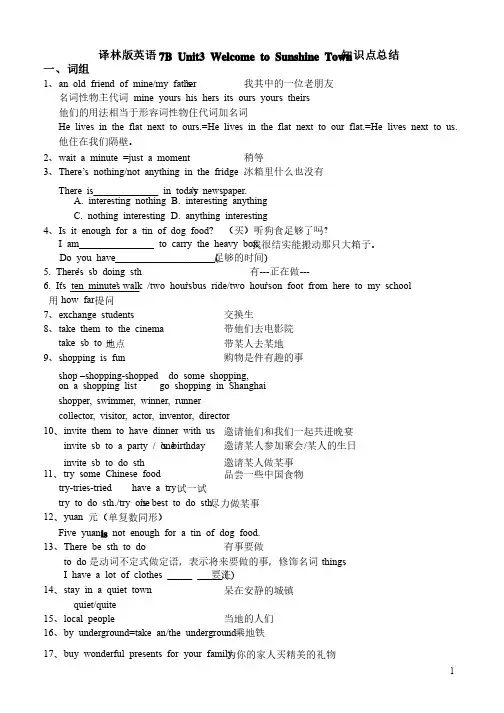
s ten minutes’ walk /two hours18、Western restaurants/food/countries 西餐馆/西餐、西方国家西餐、西方国家 19、enjoy Beijing opera 欣赏京剧欣赏京剧20、visit our local theatre 参观我们当地的剧院参观我们当地的剧院21、learn more/a lot about Chinese art 更多地了解中国的艺术更多地了解中国的艺术learn from sb. 向某人学习向某人学习向某人学习 learn a lot 学到很多学到很多学到很多learn from each other 互相学习互相学习He learned that our principal would go to Taiwan. 他得知我们校长将去台湾他得知我们校长将去台湾22、Don Don’’t miss the opera shows 别错过戏剧表演别错过戏剧表演miss doing sth/miss sb 错过做---,想念某某,想念某某 go missing 没了没了miss sth/doing sth(错过) miss sb.(想念);错误,过失(名词)I don’t want to miss __________(watch)the TV play. 失之毫厘,谬以千里______________________________________ 23、welcome to our town 欢迎来我们镇欢迎来我们镇24、look forward to meeting you 期待着见到你期待着见到你look forward to sth / doing sth 盼望某物/做某事做某事pay attention to doing /devote …to doing/prefer doing to doing/be used to doing 25、all over the place 满地是满地是all over/around the world 26、a day at the Palace Museum 在故宫的一天在故宫的一天27、works of art 艺术品艺术品work 作品(可数) 工作(不可数)也可做动词 这项工作很艰苦,我们应该努力工作去完成。
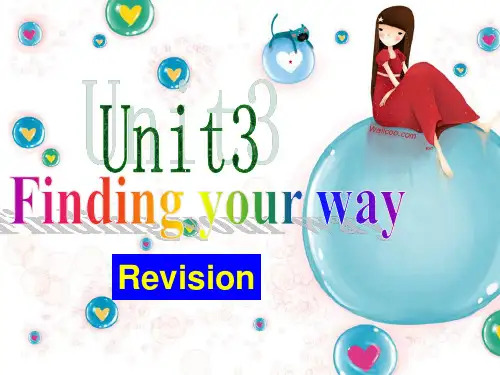
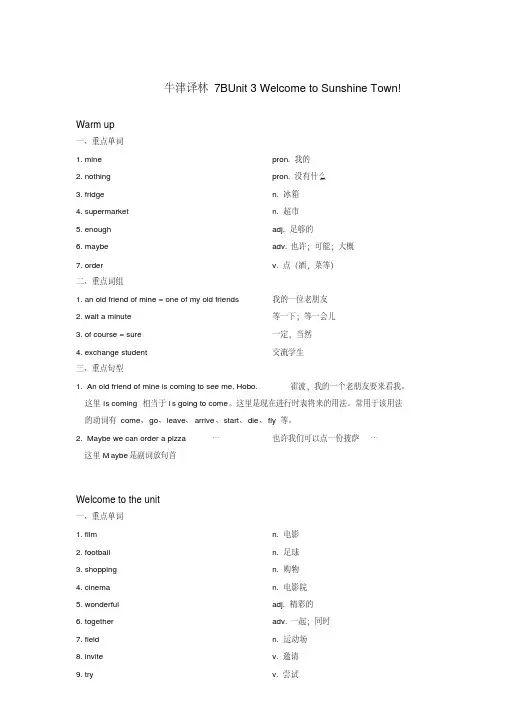
牛津译林7BUnit 3 Welcome to Sunshine Town!Warm up一、重点单词1. mine pron. 我的2. nothing pron. 没有什么3. fridge n. 冰箱4. supermarket n. 超市5. enough adj. 足够的6. maybe adv. 也许;可能;大概7. order v. 点(酒,菜等)二、重点词组1. an old friend of mine = one of my old friends我的一位老朋友2. wait a minute等一下;等一会儿3. of course = sure一定,当然4. exchange student交流学生三、重点句型1. An old friend of mine is coming to see me, Hobo.霍波,我的一个老朋友要来看我。
这里is coming 相当于i s going to come。
这里是现在进行时表将来的用法。
常用于该用法的动词有come、go、leave、arrive、start、die、fly 等。
2. Maybe we can order a pizza…也许我们可以点一份披萨…这里M aybe 是副词放句首Welcome to the unit一、重点单词1. film n. 电影2. football n. 足球3. shopping n. 购物4. cinema n. 电影院5. wonderful adj. 精彩的6. together adv. 一起;同时7. field n. 运动场8. invite v. 邀请9. try v. 尝试二、重点词组1. talk about sth.谈论某事2. take sb. to sp.带某人去某地3. invite ab. to do sth.邀请某人做某事4. I’d like to do = I want to do我想去做...三、重点句型1. We can watch some wonderful films together.我们可以一起去看一些精彩的电影。
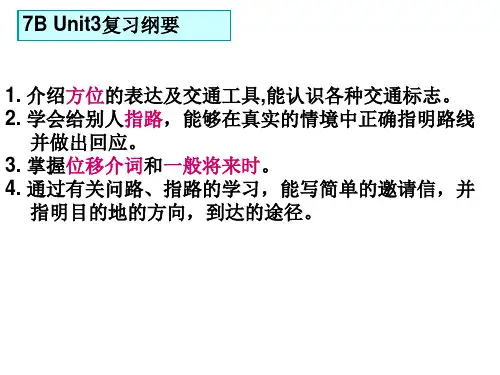
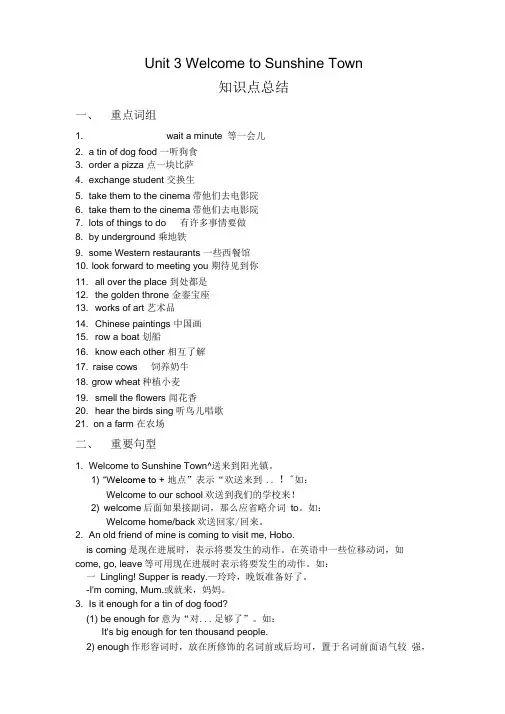
Unit 3 Welcome to Sunshine Town知识点总结一、重点词组1. wait a minute 等一会儿2. a tin of dog food 一听狗食3. order a pizza 点一块比萨4. exchange student 交换生5. take them to the cinema带他们去电影院6. take them to the cinema带他们去电影院7. lots of things to do 有许多事情要做8. by underground 乘地铁9. some Western restaurants 一些西餐馆10. look forward to meeting you 期待见到你11. all over the place 到处都是12. the golden throne 金銮宝座13. works of art 艺术品14. Chinese paintings 中国画15. row a boat 划船16. know each other 相互了解17. raise cows 饲养奶牛18. grow wheat种植小麦19. smell the flowers 闻花香20. hear the birds sing 听鸟儿唱歌21. on a farm 在农场二、重要句型1. Welcome to Sunshine Town^送来到阳光镇。
1) “Welcome to + 地点”表示“欢送来到 .. !"如:Welcome to our school欢送到我们的学校来!2) welcome后面如果接副词,那么应省略介词to。
如:Welcome home/back欢送回家/回来。
2. An old friend of mine is coming to visit me, Hobo.is coming是现在进展时,表示将要发生的动作。
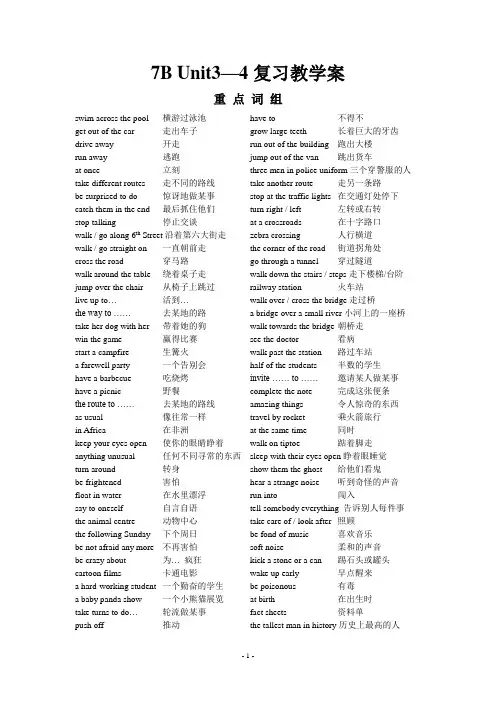
7B Unit3—4复习教学案重点词组swim across the pool 横游过泳池have to 不得不get out of the car 走出车子grow large teeth 长着巨大的牙齿drive away 开走run out of the building 跑出大楼run away 逃跑jump out of the van 跳出货车at once 立刻three men in police uniform三个穿警服的人take different routes 走不同的路线take another route 走另一条路be surprised to do 惊讶地做某事stop at the traffic lights 在交通灯处停下catch them in the end 最后抓住他们turn right / left 左转或右转stop talking 停止交谈at a crossroads 在十字路口walk / go along 6th Street沿着第六大街走zebra crossing 人行横道walk / go straight on 一直朝前走the corner of the road 街道拐角处cross the road 穿马路go through a tunnel 穿过隧道walk around the table 绕着桌子走walk down the stairs / steps走下楼梯/台阶jump over the chair 从椅子上跳过railway station 火车站live up to…活到…walk over / cross the bridge走过桥t he way to ……去某地的路 a bridge over a small river小河上的一座桥take her dog with her 带着她的狗walk towards the bridge 朝桥走win the game 赢得比赛see the doctor 看病start a campfire 生篝火walk past the station 路过车站a farewell party 一个告别会half of the students 半数的学生have a barbecue 吃烧烤invite …… to ……邀请某人做某事have a picnic 野餐complete the note 完成这张便条the route to ……去某地的路线amazing things 令人惊奇的东西as usual 像往常一样travel by rocket 乘火箭旅行in Africa 在非洲at the same time 同时keep your eyes open 使你的眼睛睁着walk on tiptoe 踮着脚走anything unusual 任何不同寻常的东西sleep with their eyes open睁着眼睡觉turn around 转身show them the ghost 给他们看鬼be frightened 害怕hear a strange noise 听到奇怪的声音float in water 在水里漂浮run into 闯入say to oneself 自言自语tell somebody everything 告诉别人每件事the animal centre 动物中心take care of / look after 照顾the following Sunday 下个周日be fond of music 喜欢音乐be not afraid any more 不再害怕soft noise 柔和的声音be crazy about 为…疯狂kick a stone or a can 踢石头或罐头cartoon films 卡通电影wake up early 早点醒来a hard-working student 一个勤奋的学生be poisonous 有毒a baby panda show 一个小熊猫展览at birth 在出生时take turns to do…轮流做某事fact sheets 资料单push off 推动the tallest man in history历史上最高的人in the daytime 在白天the weight of 6 elephants六头大象的重量eat 100 pounds of grass 吃100磅的草return ……to the museum guide把…还到博物馆的图书馆smell things as well as dogs can 能像狗一样嗅觉灵敏understand more about animals 更多地了解动物remember your words about tortoises 记住你关于乌龟的话the biggest living animals on land 陆上活着的最大的动物in the back of elephants‟ feet 在象腿的背部walk in the mud easily 在泥地里轻松的行走try to open the door with a knife 尝试用小刀打开后门push them in the back of a van 把他们推进货车后面ask them about the robbers 向他们询问小偷的事walk from the sofa to the window 从沙发走到窗户at the other side of the park 在公园的另一边take the second turning on the right 在第二个拐弯处向右转hear a whisper from the bushes 从灌木丛听到低语make a sound like a whisper 发出一个低语似的声音have enough poison to kill 有足够的毒可杀死语法精讲1. 移动的方向介词(Prepositions of movement)1) 常用的移动方向介词(词组)成反义词:down---up, from---to, into---out of, off---on有关联的:across---over, across---through---past, down---along其他:onto, round2) 使用时的注意点A. across和over:这两个单词都可以用在“过桥”时,walk across/over the bridge,over还可以表示“越过”,climb over the hill, jump over the chair, fly over;B. across和through:这两个单词都表示“穿过”,但across是“从表面横穿”,而through是“从内部穿过”,swim across the river, go across the street / playground, climb through the window, walk through the forest(森林);C. up和down是反义词,up表示“向上”,down表示“向下”。
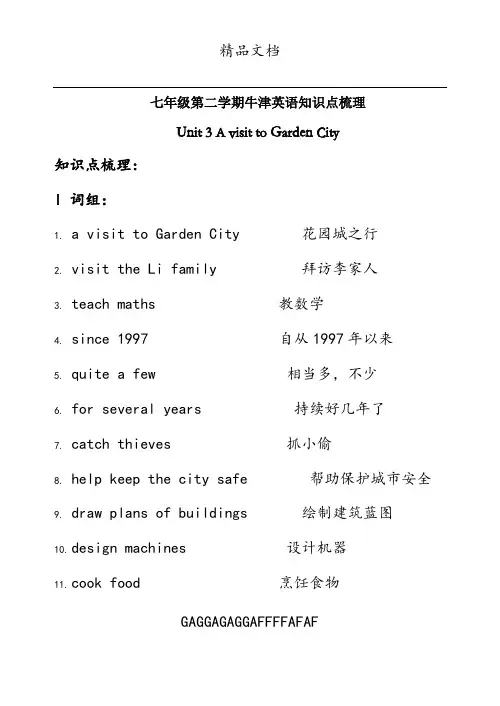
七年级第二学期牛津英语知识点梳理Unit 3 A visit to Garden City知识点梳理:I 词组:1.a visit to Garden City 花园城之行2.visit the Li family 拜访李家人3.teach maths 教数学4.since 1997 自从1997年以来5.quite a few 相当多,不少6.for several years 持续好几年了7.catch thieves 抓小偷8.help keep the city safe 帮助保护城市安全9.draw plans of buildings 绘制建筑蓝图10.design machines 设计机器11.cook food 烹饪食物GAGGAGAGGAFFFFAFAF12.bring food (to people) 端菜13.grow vegetables 种蔬菜14.type letters 打字15.answer the phone 接听电话16.deliver letters 递送信件17.train someone in sport 在体育方面训练某人18.drive a bus 驾驶公共汽车19.be in charge of a school 负责管理一所学校20.in fields 在农田里21.be used for doing sth. 被用做干某事22.tell the time 报时23.key ring 钥匙圈24.hold the keys 挂钥匙25.take the cable car 乘缆车26.carry people up the hill 运载人们上山GAGGAGAGGAFFFFAFAF27.the top of a hill 山顶28.have a good time 过得愉快II. 词性转换:1. teach (v.) 教, 讲授, 训练teacher (n.) 教师Her mother is a teacher and she teaches English. (teach)2. safe (adj.) 安全的, 可靠的safely (adv.) 安全地, 确实地GAGGAGAGGAFFFFAFAFsave (v.) 挽救,节约safety (n.) 安全,We cannot live without water. Please save every dropof water.They arrived in Shanghai safely last night.Here are some safety rules.3. use (v./n.) 使用, 应用useful (adj.) 有用的In the past, people used fire to cook food. Now, we can use fire to do a lot of things.Fire is very useful in many ways.4. farm (n.) 农场, 农庄farmer (n.)农场主; 农夫GAGGAGAGGAFFFFAFAFHis father is a farmer and he works hard on his farm. 5. wait (v.) 等待waiter (n.) (男)服务员waitress (n.) (女)服务员The restaurant is very popular, so lots of people are waiting for their dishes.The waiters and the waitresses are busing with their work.6. engine n. 引擎,发动机engineer n. 工程师A fireman always drives a fire engine.His father is an engineer.III. 语言点/句型:GAGGAGAGGAFFFFAFAF1. A watch is used for telling the time.be used for + doing sth. 意为“被用来做……”同时此句还可写成:We use a watch to tell the time.[e.g.] Water can be used for putting out fires = We can use water to put out fires.请记住以下句型:主语(人) use sth. to do …相当于主语(人) use sth. for doing…用某物做某事sth. be used to do…相当于 sth. be used for doing…某物被用来做某事IV. 语法The present perfect tense现在完成时A.概念及用法:1.表示过去发生的动作对现在造成的影响或结果。
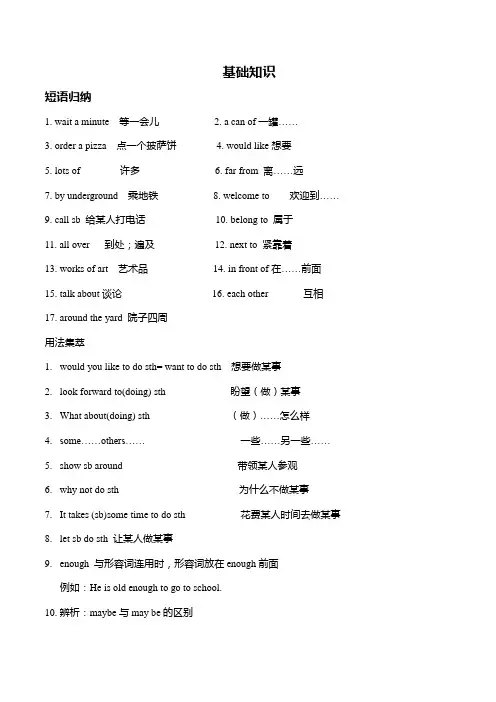
基础知识短语归纳1. wait a minute 等一会儿2. a can of一罐……3. order a pizza 点一个披萨饼4. would like想要5. lots of 许多6. far from 离……远7. by underground 乘地铁8. welcome to 欢迎到……9. call sb 给某人打电话10. belong to 属于11. all over 到处;遍及12. next to 紧靠着13. works of art 艺术品14. in front of在……前面15. talk about谈论16. each other 互相17. around the yard 院子四周用法集萃1.would you like to do sth= want to do sth 想要做某事2.look forward to(doing) sth 盼望(做)某事3.What about(doing) sth (做)……怎么样4.some……others……一些……另一些……5.show sb around 带领某人参观6.why not do sth 为什么不做某事7.It takes (sb)some time to do sth 花费某人时间去做某事8.let sb do sth 让某人做某事9.enough 与形容词连用时,形容词放在enough前面例如:He is old enough to go to school.10.辨析:maybe与may be的区别maybe是副词,意为“也许,可能,大概”;may be ——may是情态动词,be是系动词,may be 的意思是“可能是”。
例句:Maybe he is a doctor.例句:Your book may be in your bag.11.enjoy oneself=have a good time= have fun 玩得愉快12.watch拓展:watch sb do sth看见某人做过某事watch sb doing sth 看见某人正在做某事13.“There is/ are +名词+to do…… ”意思为“有……可做”例句:There is some homework to do this weekend. 这个周末有一些家庭作业要做。
知行书院学生个性化教案本学生:科目:日期:知行书院学生个性化教学方案捧着一颗心来,不带半根草去知行书院学生辅导教案学生姓名余文博学校西中授课教师何远会年级七年级上课时间1-3授课日期4-5教学目标Unit3 部分知识点讲解及练习教学重点语法和句型知识连接名词所有格教学方法讲解法、练习法、谈话法本次教学主要内容上周知识点复习巩固1.wait/just a minute 稍等片刻2.enough+名 =名 +enough形容/副+enough3.may be 可能是(情+原形)maybe 可能,大概,也4.have a good/great/wonderful time=enjoy oneself=have fun玩的愉快5.play① 奏器 play the piano② 行体育活 play football③扮演 play a role in④玩 play with6.watch sb. do sth看.某人做某事 watch sb.doing sth看某人正在做某事7.go shopping=do some/the shopping去物8.be famous for因⋯⋯⋯而著名/出名be famous as作⋯⋯⋯而出名9.belong to 属于10.look at 看一看 have a look=take a look11.all over 到;遍及all over the world 全世界12.teach sth. to sb.= teach sb. sth.教人某事teach sb.to do sth.教某人做某事tell 用法一13.works of art 品14.look after 照 look like看起来像look the same 看起来一look for 找15.look forward to (doing) sth.盼望(做)某事16.what about (doing) sth(⋯?做)⋯⋯怎么?17.There is/are+名 +to do ⋯有⋯⋯可做There is/are+主 +v.-ing..18. .however 然而(句首句中句末都可以,位于句首和句末用逗号隔开)but19.show sb. around ⋯某人参⋯⋯20.Why not do sth.?=Why don’ t you do sth.什?么不做某事知行书院学生个性化教学方案捧着一颗心来,不带半根草去21.It takes (sb.)some time to do sth. 花做某事22.hope to do sth. hope+that 从句希望⋯⋯述气wish+that 从句愿望⋯⋯虚气hope for 可能 wish for 以23.be friendly to sb. 某人友好 =be kind to sb.be friendly with sb.和某人要好24.some ⋯ others 一⋯些⋯⋯另外一些⋯⋯ some⋯ the others一⋯些⋯⋯其他的全部⋯⋯25.sometimes=at times 有 some times 几次;几倍 sometime 某 some time 一段注意:黑色加粗的是本周陪读及练习遇到N 次的练习1.Would you please speak slowly? I can not ________you.A talk withB agree withC followD hear of2.China is _______the east of the world.A inB onC atD to3.-- Susan. Would you like to go hiking with us this afternoon?-- I ’ d love to, but I ______ study for a test.A mayB have toC can4.— I can ’ t stop smoking, doctor--For. your helth, I’ m afraid you ______.A mayB canC have toD need5._______ may have a chance to be successful if he tries his best.A SomebodyB EverybodyC NobodyD None6.______turn off you mobile phone when the plane takes off.A ForgetB RememberC Forget toD Remember to7. The birds _____the trees are eating the leaves ______ the trees now.A in, onB on, inC in, inD on, on8.--I ’ m going to Hainan with my aunt for my holiday after the exam--..A Have a good timeB It doesn ’ t matterC You are welcomeD Thanks a lot 用所的正确形式填空。
牛津英语7B Unit3 单元解析Comic strip&Welcome to the unit1. An old friend of mine is coming to see me,Hobo.霍波,我的一位老朋友要来看望我。
探究点:双重所有格“名词+of+名词性物主代词/名词所有格”是双重所有格结构。
“双重所有格”是指既含有名词所有格或名词性物主代词,又含有of短语的一种表达所有关系的结构。
a neighbour of yours你的一个邻居a teacher of my sister's我妹妹的一位老师2.But there's nothing in the fridge.但是冰箱里什么也没有了。
探究点:nothing 不定代词,意为“没有什么”,表否定含义。
含有nothing的句子常被视为否定句。
nothing可与not. .anything进行同义句改写。
----What's in the room?房间里有什么?----Nothing. 没有什么。
There's nothing to do=There is not anything to do.无事可做。
3.Let's go to the supermarket.我们去超市吧。
探究点:let's后接动词_______形。
[指点迷津] let's意为“让我们”,后接动词原形。
Let's go to school.我们去上学吧。
[辨析] let's与let us(1) let's是let us的缩写,包括说话人和听话人双方在内,含有催促、建议或请对方一起行动的意思。
在听话人表示赞同建议时可只用let's。
- Let's go to Beijing by plane.我们乘飞机去北京吧。
- OK.好的。
(2)当请求对方允许自己(第一人称复数)做某事时,要用let us,这里的us不包括听话方在内,不能缩写为let's。
七年级英语牛津7B Unit 3 grammar 课件Unit 3 Finding my wayGrammarUnit 3 Finding my wayGrammarPrepositions of movement方向移动介词round 围绕The earth goes round the sun.1.他正在开车环绕这座城市。
He’s driving round the city.2.一个男孩正在围绕操场跑。
A boy is running round the playground.roundthrough 穿过The boy is walking through the tunnel.tunneltunnel 隧道1.那个男人正在穿过森林。
The man is walking through the forest.2.光透过窗户。
The light shines through the window.throughacross 横过The swimmer is swimming across the swimming pool.1.过马路时你应小心。
Be careful when you walk across the street.2.长江上有几座桥?How many bridges are there across the Changing River?acrossover越过,、从…上边过去They are running over the hurdle.over1.那孩子爬过了墙。
The boy is climbing over the wall.2.有只猫跳过了那张椅子。
There is a cat jumping over the that chair.along 沿着。
7B Unit 3 Encyclopaedia Vocabulary:1. n.百科全书2. n. 恐龙3. n. 加拿大人adj. 加拿大(人)的4. adv. 处处;到处5. vt. 创作;产生6. n. 翼;翅膀7. v. 存在,有;生存8. n. 人类(可数)9. adv. 甚至10. adj.温和的11. n. 植物12. adj. 凶猛的;凶狠的13. n. 化石14. n. 骨骼;骷髅15. n. 脚印;足迹16. n. 迪斯尼乐园17. n. 游乐园18. vt. 创办,成立;建立19. v. 递送;交付20. n. 邮件;邮包21. n. 明星,名角22. adj. 吓人的;可怕的23. adj. 正确的,对的vt. 改正24. adj.必要的;必然的25. adv. 大概;或许;可能26. adv. 正确地;精确地27. adj. 整体的;笼统的,大致的28. n. 疾病29. v. 预言;预测30. n. 陵墓31. v. 修理;修补32. n. 屋顶;顶部33. n. 鳄鱼34. n. 复数(形式) adj. 复数的35. n. 音节36. v. 发音;读37. n. 连字符38. n. 算盘39. n. 比赛;竞赛40. n. 括弧41. n. 生产者;制片人42. n. 百万45. n. 参观者;游客46. v. 收到;接到47. 卡通人物48. 建立在……的基础上49. 同时50. 从前,很久以前51. (指物种、家族、习惯、观念等)绝迹, 消失52. (一组生命体)一个接一个地死去直到死光53. 许多的54. 注意55. 照顾56. 整年;全年57. 由……组成58. 去散步59. 以……形式Paraphrase1. The mausoleum is built in the memory of Dr Sun Y at-sen.2. I spent 2 hours mending the DVD.3. We should give a name to the lovely puppy.4. They were late because it rained heavily.5. The cat gave birth to a baby cat last night.6. Y ou can find trees here and there in Shenzhen.7. Cathy bought Aileen a camera.8. Dinosaurs don’t exist any more.9. The history of China is longer than that of America.10. Simon began working after he left school.11. Please look after yourself.12. The building is 11 meters high.13. Remember to make a list of the things you want to buy before you go shopping.14. Let’s go for a walk together after dinner.15. What kind of movie do you like best?16. Please write down the things on the blackboard.17. Walt Disney used a pen to draw his cartoons.18. Susana saw that Meg entered the classroom.19. Can you predict the result of the game?。